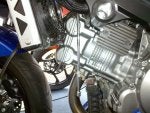Well, it's a long time coming, with me having to move to a new residence and such, but I promised AndyW I'd get the job done.
Secondary throttle valves....There are many thoughts on just what the heck they do. Some say it's for noise abatement, others think they just get in the way, and affect the true performance of the bike, and some would just rather remove them.
I should point you in the direction of my tech article about Carburetors.
More directed to the "Constant Velocity" type.
Since the introduction of fuel injection, we no longer require a pressure drop through a ventury to pull fuel from a fuel bowl, and introduce it into the engine. We have a fuel pump that sends pressurized fuel to fuel injectors, and thanks to IC chips, and sensors, we can spray the fuel into the engine. No need for fancy needle jets, main jets, primary jets, and airbleed jets. Nevermind making sure the fuel level in the carb bowls is the correct height.
There is one thing that's important with the CV carburetor, and that's how it keeps the air velocity constant through the intake ports regardless of throttle position. If you ever had flat slide carbs, and immediately opened the throttle, you would notice that the engine would take a big gulp of air, and hesitate, or even stall. Accelerator pumps were introduced to keep this in check. So, in regards to keeping air velocities constant especially at lower engine rpms, one concept for a fuel injected engine is to add separately controlled throttle plates that can move independently from the main throttle plates. This way, if the throttle plates are opened quickly, air velocity will drop, but with the Secondary Throttle plates lagging just behind, can keep the air velocity up, and help with atomization of the fuel injected into the engine. of course if you are racing the bike, and it never sees rpms below 6 to 7,000 rpms, there is no sense on having the secondary throttle plates there, and can be removed for some added increase of air. Most of us don't race, and use the engine through a wide range of rpms, and with the STV's installed really doesn't detract from performance, but keeps it more tractable.
Now, enough said about how they work, lets see how we adjust them.
Maui, aka (Dave), was kind enough to donate his bike, (and get some free work done) by yours truely.
We first started to check his Throttle position sensor... (see Chewy's killer Tech tip), and found that we needed to make a small adjustment.
After that was all and done, we had at the STV's.
There are basically 3 parts to this arrangement.
1. The STV's.
2. The servo motor that drives them.
3. The STV position sensor that tells the ECU where they are in position.
First thing to do is raise the tank, and remove the airbox assembly. Those Pair valve hoses are a BITCH! (Hint Dave...Loose the pair..)
There are several connectors that need to be uncoupled to facilitate the removal. Just remember where they go, once you tend to the task at hand.
First thing to identify, is the STV's it's kind of a no brainer, but we want to cover everything...This is pic #1
Next is the servo mechanism, pic #2
And finally the STV position sensor pic #3
We now want to find the connector at the STV positon sensor, the wire loom is actually folded and tied together. pic #4.
Secondary throttle valves....There are many thoughts on just what the heck they do. Some say it's for noise abatement, others think they just get in the way, and affect the true performance of the bike, and some would just rather remove them.
I should point you in the direction of my tech article about Carburetors.
More directed to the "Constant Velocity" type.
Since the introduction of fuel injection, we no longer require a pressure drop through a ventury to pull fuel from a fuel bowl, and introduce it into the engine. We have a fuel pump that sends pressurized fuel to fuel injectors, and thanks to IC chips, and sensors, we can spray the fuel into the engine. No need for fancy needle jets, main jets, primary jets, and airbleed jets. Nevermind making sure the fuel level in the carb bowls is the correct height.
There is one thing that's important with the CV carburetor, and that's how it keeps the air velocity constant through the intake ports regardless of throttle position. If you ever had flat slide carbs, and immediately opened the throttle, you would notice that the engine would take a big gulp of air, and hesitate, or even stall. Accelerator pumps were introduced to keep this in check. So, in regards to keeping air velocities constant especially at lower engine rpms, one concept for a fuel injected engine is to add separately controlled throttle plates that can move independently from the main throttle plates. This way, if the throttle plates are opened quickly, air velocity will drop, but with the Secondary Throttle plates lagging just behind, can keep the air velocity up, and help with atomization of the fuel injected into the engine. of course if you are racing the bike, and it never sees rpms below 6 to 7,000 rpms, there is no sense on having the secondary throttle plates there, and can be removed for some added increase of air. Most of us don't race, and use the engine through a wide range of rpms, and with the STV's installed really doesn't detract from performance, but keeps it more tractable.
Now, enough said about how they work, lets see how we adjust them.
Maui, aka (Dave), was kind enough to donate his bike, (and get some free work done) by yours truely.
We first started to check his Throttle position sensor... (see Chewy's killer Tech tip), and found that we needed to make a small adjustment.
After that was all and done, we had at the STV's.
There are basically 3 parts to this arrangement.
1. The STV's.
2. The servo motor that drives them.
3. The STV position sensor that tells the ECU where they are in position.
First thing to do is raise the tank, and remove the airbox assembly. Those Pair valve hoses are a BITCH! (Hint Dave...Loose the pair..)
There are several connectors that need to be uncoupled to facilitate the removal. Just remember where they go, once you tend to the task at hand.
First thing to identify, is the STV's it's kind of a no brainer, but we want to cover everything...This is pic #1
Next is the servo mechanism, pic #2
And finally the STV position sensor pic #3
We now want to find the connector at the STV positon sensor, the wire loom is actually folded and tied together. pic #4.








